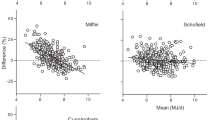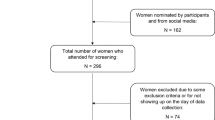Abstract
Objective: To develop, validate, and cross-validate a formula for predicting resting energy expenditure (REE) in African-American and European-American women.
Design: A cross-sectional study of REE in women. Participants were randomly assigned to one of two groups. One group served to develop and validate a new equation for predicting REE while the second was used to cross-validate the prediction equation. The accuracy of the equation was compared to several existing formulae.
Setting: University metabolic laboratory, Memphis, TN, USA.
Subjects: Healthy, premenopausal African-American and European-American women between 18 and 39 y of age. The validation sample included 239 women (age: 28.4 y, wt: 70.7 kg, body mass index (BMI): 25.2 kg/m2, REE: 5840 kJ/day), while the cross-validation sample consisted of 232 women (age: 27.5 y, wt: 70.7 kg, BMI: 25.2 kg/m2, REE: 5784 kJ/day).
Results: The prediction equation derived from the current sample, which included adjustments for ethnicity, was the only formula that demonstrated a high level of accuracy for predicting REE in both African-American and European-American women. The mean difference between REE predicted from the new formula and measured REE was 28 kJ/day (s.d.=668) for European-American women and 142 kJ/day (s.d.=584) for African-American women.
Conclusions: Previous equations for predicting energy needs may not be appropriate for both African-American and European-American women due to ethnic differences in REE. A new equation that makes adjustments in predicted REE based on ethnicity is recommended for determining energy needs in these groups (Predicted REE (kJ/day)=616.93−14.9 (AGE (y))+35.12 (WT (kg))+19.83 (HT (cm))−271.88 (ETHNICITY: 1=African American; 0=European American)).
Sponsorship: Support for this study was provided by Grant #HL53261 from the National Heart, Lung, and Blood Institute.
This is a preview of subscription content, access via your institution
Access options
Subscribe to this journal
Receive 12 print issues and online access
$259.00 per year
only $21.58 per issue
Buy this article
- Purchase on Springer Link
- Instant access to full article PDF
Prices may be subject to local taxes which are calculated during checkout

Similar content being viewed by others
References
Albu J, Shur M, Curi M, Murphy L, Heymsfield SB & Pi-Sunyer FX (1997): Resting metabolic rate in obese, premenopausal black women. Am. J. Clin. Nutr. 66, 531–538.
Arciero PJ, Goran MI, Gardner AM, Ades PA, Tyzbir RS & Poehlman ET (1993): A practical equation to predict metabolic rate in older females. J. Am. Geriatr. Soc. 41, 389–395.
Benedict FG (1932): The racial element in human metabolism. Am. J. Phys. Anthropol. 16, 463–473.
Berke EM, Gardner AW, Goran MI & Poehlman ET (1992): Resting metabolic rate and the influence of the pretesting environment. Am. J. Clin. Nutr. 55, 626–629.
Bland, JM (2001): Comparing within-subjects variances in a study to compare two methods of measurement. Online statistical reference: http://mbland.sghms.ac.uk/compsd.htm.
Bland JM & Altman DG (1986): Statistical methods for assessing agreement between two methods of clinical measurement. Lancet 1, 307–310.
Daly JM, Heymsfield SB, Head CA, Harvey LP, Nixon DW, Katzeff H & Grossman GD (1985): Human energy requirements: overestimation by widely used prediction equation. Am. J. Clin. Nutr. 42, 1170–1174.
FAO/WHO/UNU (1985): Energy and Protein Requirements. Technical Report Series, No. 724. Geneva: World Health Organization.
Finan K, Larson E & Goran MI (1997): Cross-validation of prediction equations for resting energy expenditure in young, healthy children. J. Am. Diet. Assoc. 97, 140–145.
Foster GD & McGuckin BG (2001): Estimating resting energy expenditure in obesity. Obes. Res. 9, 367S–372S.
Frankenfield DC, Muth ER & Rowe WA (1998): The Harris–Benedict studies of human basal metabolism: history and limitations. J. Am. Diet. Assoc. 98, 439–445.
Gannon B, DiPietro L & Poehlman ET (2000): Do African Americans have lower energy expenditure than Caucasians? Int. J. Obes. Relat. Metab. Disord. 22, 4–13.
Glynn CC, Greene GW, Winkler MF & Albina JE (1999): Predictive agreement between measured energy expenditure using limits-of-agreement analysis in hospitalized, obese patients. J. Parenter. Enter. Nutr. 23, 147–153.
Harris JA & Benedict FG (1919): A Biometric Study of Basal Metabolism in Man. Washington, DC: Carnegie Institute of Washington.
Henry CJK & Rees DG (1991): New predictive equations for the estimation of basal metabolic rate in tropical peoples. Eur. J. Clin. Nutr. 45, 177–185.
Heshka S, Feld K, Yang M, Allison DB & Heymsfield SB (1993): Resting energy expenditure in the obese: a cross-validation and comparison of prediction equations. J. Am. Diet. Assoc. 93, 1031–1036.
Huszczuk A, Whipp BJ & Wasserman K (1990): A respiratory gas exchange simulator for routine calibration in metabolic studies. Eur. Respir. J. 3, 465–468.
Isbell TR, Klesges RC, Meyers AW & Klesges LM (1991): Measurement reliability and reactivity using repeated measures of resting energy expenditure with a face mask, mouthpiece, and ventilated canopy. J. Parenter. Enter. Nutr. 15, 165–168.
Jakicic JM & Wing RR (1998): Differences in energy expenditure in African American vs. Caucasian overweight females. Int. J. Obes Relat. Metab. Disord. 22, 236–242.
Kimm SYS, Glynn NW, Aston CE, Poehlman ET & Daniels SR (2001): Effects of race, cigarette smoking, and use of contraceptive medications on resting energy expenditure in young women. Am. J. Epidemiol. 154, 718–724.
Kimm SYS, Glynn NW, Aston CE, Damcott CM, Poehlman ET, Daniels SR & Ferrell (2002): Racial differences in the relation between uncoupling protein genes and resting energy expenditure. Am. J. Clin. Nutr. 75, 714–719.
Kumanyika SK (1999): Understanding ethnic differences in energy balance: can we get there from here? Am. J. Clin. Nutr. 70, 1–2.
Mifflin MD, St Jeor ST, Hill LA, Scott BJ, Daugherty SA & Koh YO (1990): A new predictive equation for resting energy expenditure in healthy individuals. Am. J. Clin. Nutr. 51, 241–247.
Nicklas BJ, Toth MJ, Goldberg AP & Poehlman ET (1997): Racial differences in plasma leptin concentrations in obese premenopausal women. J. Clin. Endocrinol. Metab. 82, 315–317.
Owen OE, Kavle E, Owen RS, Polansky M, Caprio S, Mozzoli MA, Kendrick ZV, Bushman MC & Boden G (1986): A reappraisal of caloric requirements in women. Am. J. Clin. Nutr. 44, 1–19.
Pedhazur EJ (1982): Multiple Regression in Behavioral Research, 2nd Edition, pp 149–150. Fort Worth, TX: Harcourt Brace Jovanovich, Inc.
Schofield WN, Schofield C & James WPT (1985): Basal metabolic rate. Hum. Nutr.: Clin. Nutr. 39C (Suppl 1), 5–41.
Sharp TA, Bell ML, Grunwald GK, Schmitz KH, Sidney S, Lewis CE, Tolan K & Hill JO (2002): Differences in resting metabolic rate between white and African-American young adults. Obes. Res. 10, 726–732.
Webb P (1986): Twenty-four hour energy expenditure and the menstrual cycle. Am. J. Clin. Nutr. 44, 614–619.
Weir JB de V (1949): New methods for calculating metabolic rate with special reference to protein metabolism. J. Physiol. 109, 1–9.
Weyer C, Snitker S, Bogardus C & Ravussin E (1999): Energy metabolism in African Americans: potential risk factors for obesity. Am. J. Clin. Nutr. 70, 13–20.
Author information
Authors and Affiliations
Contributions
Guarantor: MW Vander Weg.
Contributors: MWV was the primary author and data analyst. JMW also contributed to data analysis and interpretation, as well as data collection and management. RCK was the Principal Investigator for the parent study, and was responsible for its design and methodology. LHEC was Co-Principal Investigator, and assisted with the administration and scientific oversight of the study. DLS was the Project Coordinator, and supervised the day-to-day management of the study. BSM was director of the metabolic laboratory, and supervised all aspects of metabolic data collection. All six authors contributed to the preparation of the manuscript.
Corresponding author
Rights and permissions
About this article
Cite this article
Vander Weg, M., Watson, J., Klesges, R. et al. Development and cross-validation of a prediction equation for estimating resting energy expenditure in healthy African-American and European-American women. Eur J Clin Nutr 58, 474–480 (2004). https://doi.org/10.1038/sj.ejcn.1601833
Received:
Revised:
Accepted:
Published:
Issue Date:
DOI: https://doi.org/10.1038/sj.ejcn.1601833
Keywords
This article is cited by
-
Do we need race-specific resting metabolic rate prediction equations?
Nutrition & Diabetes (2019)
-
Estimation of basal metabolic rate in Chinese: are the current prediction equations applicable?
Nutrition Journal (2015)
-
Resting Energy Expenditure Changes With Weight Loss: Racial Differences
Obesity (2010)



